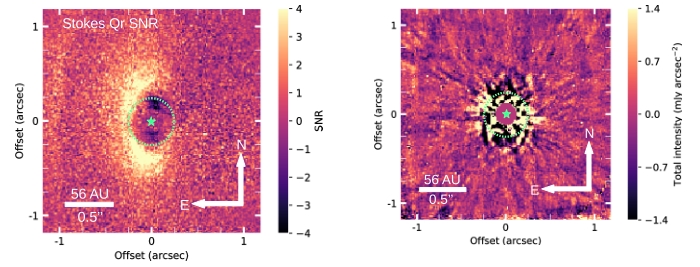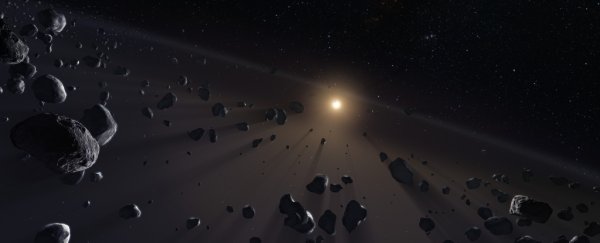How typical is our Solar System? The question bedevils planetary scientists, but making detections of analogous features in other planetary systems is pretty hard. Yet astronomers have just made one - of a Kuiper belt-like feature around a star 320 light-years away.
It is, they say, the first polarimetric detection of the inner ring circling the star we call HD 141569A. And it's revealing new details about a crucial period of planetary development.
HD 141569A is actually a pretty interesting and well-studied object. It has two companions in a trinary system, both red dwarfs. But HD 141569A is just 5 million years old, around three times the mass of the Sun, of a blue spectral type burning hot and bright.
In 1999, a disc was discovered around the young star, with two rings peaking at 220 and 360 astronomical units, respectively. These are the remnants of material that swirled around and accreted into the star as it was forming; over time, bits of material start sticking to each other, accreting into planets.
In HD 141569A's disc, a gap between the two rings suggested that a planet was forming, gravitationally hoovering up all the material in its orbit.
Here in the Solar System, we also have remnants of the Sun's accretion disc from its formation 4.6 billion years ago. We call it the Kuiper belt, and it's a puffy disc of icy debris out beyond the orbit of Neptune. Pluto, at an average distance of 39.5 astronomical units, is in the Kuiper belt.
Towards the end of this planetary accretion process, what is left is known as a debris disc, and it can extend hundreds of astronomical units across. The disc around HD 141569A is a hybrid - it's in transition between a protoplanetary disc and a debris disc.
Hybrid discs are fascinating to planetary scientists, since they can tell us about how gas giants form, and how growing planetesimals interact with the gas and dust in the disc.
Now, by studying scattered and twisted electromagnetic radiation from the region around the star, astronomers led by Juan Sebastian Bruzzone of The University of Western Ontario in Canada have imaged a similar ring around HD 141569A, peaking at a distance of 44 astronomical units from the star.
 (Bruzzone et al., arXiv, 2019)
(Bruzzone et al., arXiv, 2019)
And they have found not just evidence of planetary formation, but hints that there's another ring structure in the disc closer to the star.
Specifically, they found a spiral arm - a feature found in a few other protoplanetary discs, including the two outer rings of HD 141569A, and taken to be the evidence of a forming planet. Based on the features of the spiral arm, the researchers inferred the planet would be around Jupiter's mass or slightly smaller.
They also compared their observed emission to models to find the best fit for the type of dust that could have produced it. But, even with the best-fit models, there was emission that couldn't be accounted for.
However, when another ring located closer to the star was added to the calculations, this solved the problem. A belt between 5 and 15 astronomical units reproduced the emission beautifully.
Aside from the fact that it's pretty danged amazing that astronomers can even achieve such a detection, this is the sort of finely detailed study that can tell us how planets are born.
In turn, that can tell us more about our own Solar System - and knowing how normal or unusual it is can help us figure out how the heck we got here at all.
"Considering resolved imaging data from other high-contrast facilities, the HD 1415169A debris disc shapes up to be made of at least three, and potentially four nested rings, with spiral structures on the three spatially resolved rings," the researchers wrote in their paper.
"As such, it is an excellent laboratory for studying dynamically perturbed discs."
The research has been accepted into The Astronomical Journal, and is available on arXiv.
